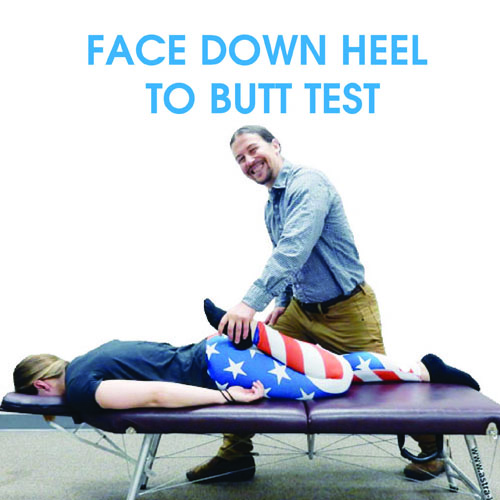
16 Jul Know Your Numbers: Face Down Heel to Butt Test
Your quadriceps is made up of 4 different muscles. Quad = 4. ~Barefoot Rehab
The Face-Up Heel to Butt Test allowed us to check knee joint integrity and 3 of the 4 quadriceps muscles.
The Face-Down Heel to Butt Test will allow us to check for the last quadriceps muscle.
Mobility: Face-Down Heel to Butt Test | Prone Knee Flexion (PKF)
This is a more advanced test than the Face-Up Heel to Butt Test.
This test should not be done unless the Face-Up Heel to Butt Test is a pass. If the Face-Up Heel to Butt Test is a fail, this test will show up as a false positive and you might think you can safely stretch the quad. You can’t safely stretch the quad unless the Face-Up version is a pass.
The ability to bring one’s heel to her butt is checking for restriction in a primary force producer of the hip + knee. The “Face-Down Heel to Butt Test”, or in mechanical terms, prone knee flexion, will let us know if you have that ability.
What do I need to Measure this Test? You will need a flat surface to lie on, a ruler, and a friend to help you measure this test.
What is the Face-Down Heel to Butt Test assessing? The mobility of your knee joint integrity was tested directly with the Face-Up version of this test. While this test does test the knee joint + the three vastus quadriceps muscles, I suggest you don’t use this test for those structures. It will complicate things. This test IS testing rectus femoris, which crosses the hip joint. The vastus muscles do not – which is why you test the vastus muscles in hip flexion, not a neutral hip like this test or an extended hip like in the lunge stretch test.
What Specific Dysfunctions are relevant here? Adhesion in the rectus femoris or between the rectus femoris + the deeper vastus muscles is the most common dysfunction here.
Again, knee joint pathologies was hopefully ruled in or out with the Face-Up version of this test.
What You Need to Know: As a more advanced test, I don’t use this test often in practice. It’s not as relevant for pain-free living. However, it is relevant to performance. Adhesion in the quads can directly affect the stamina, strength, and flexibility of any lower body movement. Therefore, this test is most relevant for athletes and performance-savvy individuals.
How to Test:
Make sure you pass the Face-Up version before continuing.
Lie face-down on the ground or a table. Your friend should take your leg + push your heel to your butt.
If your heel doesn’t touch your butt, your friend can measure the distance from your butt with finger breadths (see below). If you’re very restricted, use a ruler to see how far your heel is from your butt.
If your heel does touch your butt, your friend should pin your heel down to your butt while lifting your knee. It’s difficult for your friend to measure since his/her hands are tied up with both hands. Your friend should eye for about 3″ of distance between the knee + the surface.
Write this number down. Any mobilization, stretching, or treatment interventions are attempts to increase this number. If the number isn’t increased after a month, you’re wasting your time.
PASS:
A pass for this test is the ability to bring your heel to your butt.
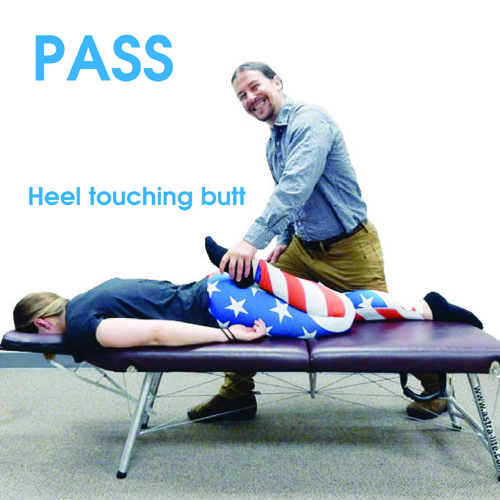
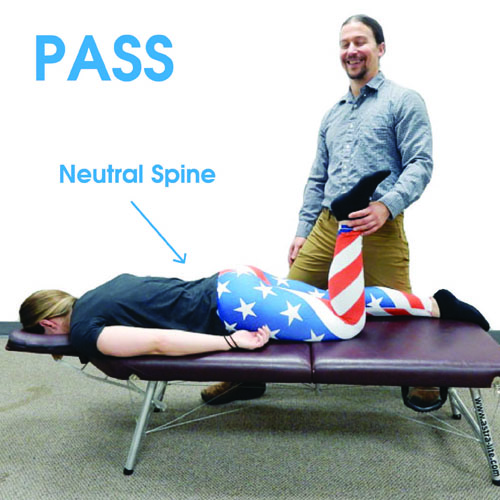
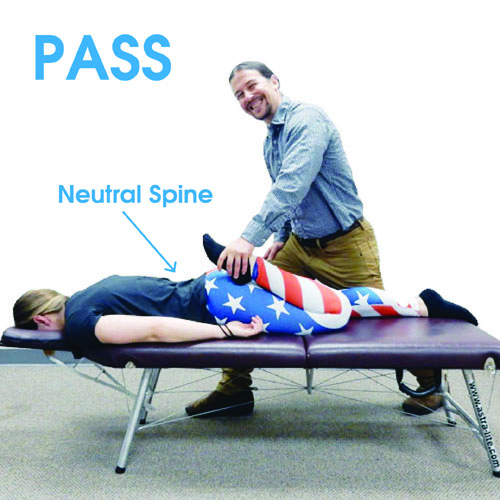
- Range: Touching. The low back should still have its normal, resting, neutral arch.
- Effort: Fast and easy.
- Symptoms: No symptoms. No symptoms includes the feeling of a stretch. Ideally, there would be no stretch.
PASS – EXTRA CREDIT:
A pass with extra credit is the ability for your friend to keep your heel pinned to your butt while lifting your knee off the table 3″.
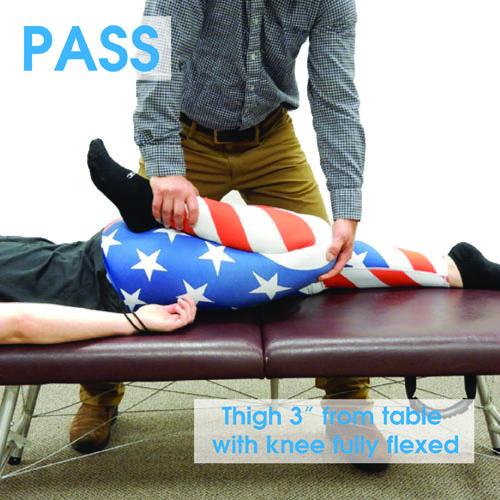
- Range: The knee more than 3″ from the table, eyed without measuring.
- Effort: Easy.
- Symptoms: If low back symptoms are present with the heel to butt part or the knee from the table part, the quad should be addressed as it is pulling the low back into hyper-extension. The low back does not like hyper-extension.
FAIL – LOW RISK:
A fail with a low risk of injury is anywhere from the heel touching the butt to 2 finger breadths away.
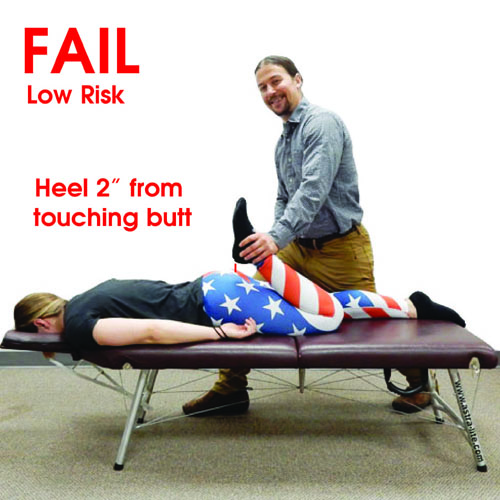
- Range: not touching the butt.
- Effort: labored at the end range. A soft-end feel implies the muscle is stopping the range of motion. A hard-end feel implies you skipped the Face-Up version of this test. Put your hand out so I can slap it! ; )
- Symptoms: You may feel a pull in quad. This is indicative of the rectus femoris having adhesion.
Because this is a test for diminishing returns of the average population, there is no high risk fail for this test if someone passes the Face-Up version of this test (and has a healthy knee joint), but not the Face-Down version.
I Know My Numbers – What do I do now?
Insanity: doing the same thing over and over again and expecting different results. ~Albert Einstein
There are a plethora of mobility and stretching resources out in the interweb for you to experiment with. It is not our intention to give prescriptive answers, simply to bring awareness to where your body currently is in time.
Use whatever tools you’d like to use for a month, stretching about ten minutes a day, for three days a week, for a month.
After a month, re-test.
If you’ve gained range of motion, wonderful! Wash, rinse, repeat, and continue stretching.
If you’re no more flexible or mobile than you were before, STOP THE INSANITY AND THE STRETCHING! It’s now time to see a Manual Adhesion Provider or Active Release Technique Provider to diagnose your condition and potentially remove the adhesion in relevant tissue to restore your mobility before you go on layering strength on top of unhealthy tissue.
While you’re awaiting 30 days from now to reassess, you might as well get baseline measurements for your hip flexion, hip extension, ankles and your low back.
 What are you numbers? Please share range, effort, and symptoms below and we can discuss what you should be doing to restore musculoskeletal integrity.
What are you numbers? Please share range, effort, and symptoms below and we can discuss what you should be doing to restore musculoskeletal integrity.


Know Your Numbers: The Lunge Stretch Test
Posted at 17:48h, 16 July[…] the shoe) from the ground. Read more about the rectus femoris by testing yourself with the face-down heel to butt test + doing the couch […]
Know Your Numbers: Face Down Heel to Butt Test | Primal Docs
Posted at 12:43h, 18 July[…] Know Your Numbers: Face Down Heel to Butt Test […]
Mary Lester
Posted at 00:17h, 18 AprilMy heel to butt can’t happen as my knee hurts on the inner side of left leg and the back of knee hurts to bad to bull up to butt . Comes up about 5inch from butt ? I have been icing the back of the knee. Isn’t helping. It’s been 3 weeks . Should I give it more time or see a doctor?
Dr. Chris
Posted at 11:27h, 18 AprilHi Mary, Can you tell me the results to the Face-Up Heel-to-Butt Test first? I can’t give you a good answer without the info from this. https://www.barefootrehab.com/know-your-numbers-face-up-heel-to-butt-test/
With what you’ve told me, my guess is that it will be limited and produce symptoms in the BACK of your knee. If this is true, you’ll likely need an MRI as “back of the knee symptoms” are highly correlated with structural knee damage (not a muscular problem). Where do you live? Are there any Integrative Diagnosis providers near you?
Abrahamdiemn
Posted at 08:55h, 05 Novemberhttp://trezvyvoditel.flyland.ru/
Avishek Shaw
Posted at 16:31h, 27 JuneMy medial side of knee snaps while touching my knee to my hip.
Dr. Chris
Posted at 14:32h, 04 JulyHmm, you’d need an exam to see what’s going on there. Could be plica, osteoarthritis, or adhesion in knee tissue.
Robert
Posted at 11:49h, 20 JulyI can’t even run at all I have such issues with this .
Dr. Chris
Posted at 22:52h, 20 JulySorry to hear Robert. We are here in NJ if you can make it.